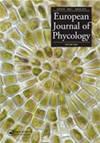The long-term exposure of cyanotoxin, cylindrospermopsin, on the macrophyte Lemna trisulca
IF 1.7
4区 生物学
Q2 MARINE & FRESHWATER BIOLOGY
引用次数: 1
Abstract
ABSTRACT The increase in frequency and prevalence of cylindrospermopsin (CYN)-producing cyanobacteria blooms have become a growing problem worldwide. Therefore, the long-term effects of CYN on the physiological processes of the macrophyte, Lemna trisulca, were examined. During a 5-day exposure to a range of CYN concentrations (0.5, 1 and 5 μg ml−1), the low levels of stress experienced by L. trisulca stimulated its growth rate and photosynthesis and led to an increase in the synthesis of photosynthetic pigments. In turn, it was shown that a 3-week exposure to the highest tested CYN concentration (5 μg ml−1) resulted in the inhibition of biomass accumulation (by 7.6%) compared with that of the control plants, but necrosis and chlorosis were not observed. A negative correlation with the concentration of carotenoids was also observed, which may suggest that the antioxidant mechanisms of L. trisulca are effective only up to a certain CYN concentration. An increase in protein content in the tissues of macrophytes treated with concentrations of CYN ranging from 0.5 to 5 μg ml−1 indicates that the toxin did not inhibit protein synthesis but increased the metabolism of L. trisulca, potentially to provide energy for defence. The toxin also affects the homeostasis of mineral ions in cells. This is the first description of the physiological response of L. trisulca to the long-term effects of a wide range of CYN concentrations.柱状藻毒素对三溃疡柠檬的长期暴露
摘要产生柱状菌素(CYN)的蓝藻水华的频率和流行率的增加已成为世界范围内日益严重的问题。因此,研究了CYN对大型植物三溃疡柠檬生理过程的长期影响。在一系列CYN浓度(0.5、1和5μg ml−1)下暴露5天期间,三溃疡乳杆菌所经历的低水平胁迫刺激了其生长速率和光合作用,并导致光合色素的合成增加。反过来,研究表明,与对照植物相比,暴露于测试的最高CYN浓度(5μg ml−1)3周可抑制生物量积累(7.6%),但未观察到坏死和黄化。还观察到与类胡萝卜素浓度呈负相关,这可能表明三溃疡乳杆菌的抗氧化机制仅在一定的CYN浓度下有效。用浓度为0.5至5μg ml−1的CYN处理的大型植物组织中蛋白质含量的增加表明,该毒素没有抑制蛋白质合成,但增加了三溃疡乳杆菌的代谢,可能为防御提供能量。这种毒素还会影响细胞中矿物质离子的稳态。这是首次描述三溃疡乳杆菌对各种CYN浓度的长期影响的生理反应。
本文章由计算机程序翻译,如有差异,请以英文原文为准。
求助全文
约1分钟内获得全文
求助全文
来源期刊

European Journal of Phycology
生物-海洋与淡水生物学
CiteScore
4.80
自引率
4.20%
发文量
37
审稿时长
>12 weeks
期刊介绍:
The European Journal of Phycology is an important focus for the activities of algal researchers all over the world. The Editors-in-Chief are assisted by an international team of Associate Editors who are experts in the following fields: macroalgal ecology, microalgal ecology, physiology and biochemistry, cell biology, molecular biology, macroalgal and microalgal systematics, applied phycology and biotechnology. The European Journal of Phycology publishes papers on all aspects of algae, including cyanobacteria. Articles may be in the form of primary research papers and reviews of topical subjects.
The journal publishes high quality research and is well cited, with a consistently good Impact Factor.
 求助内容:
求助内容: 应助结果提醒方式:
应助结果提醒方式:


